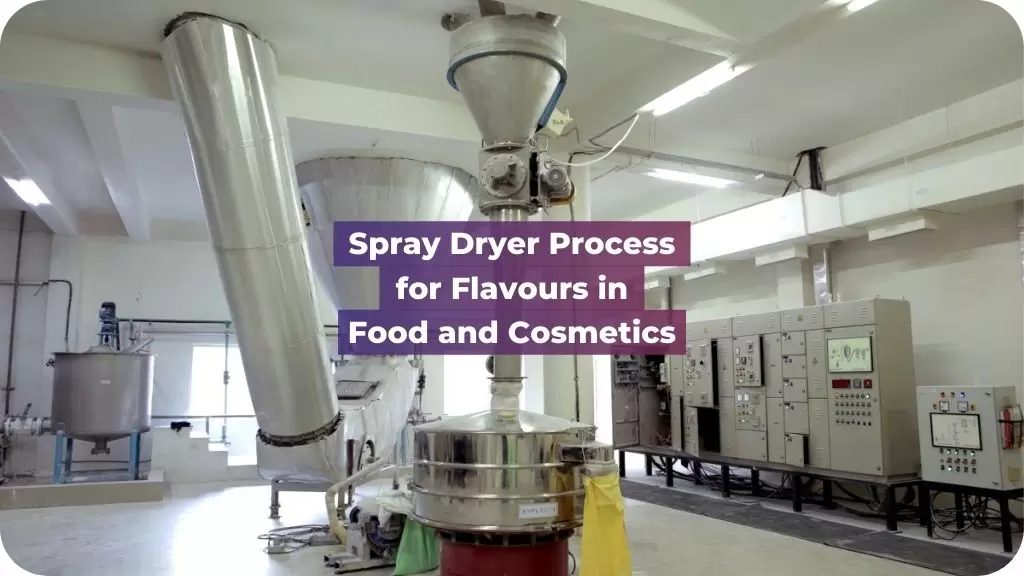Production of dry flavorings is achieved easily with spray drying. The Spray Drying process involves an aqueous feed material which includes water, carrier, and the flavor is atomized into a stream of hot air. The atomized articles tend to dry rapidly. The volatile flavor constituents is trapped inside the droplets. The powder is sometimes recovered via cyclone collectors.
Choosing the right operating parameters is critical to flavor retention. Since spray drying technique is equally good in handling of both water soluble and oil-soluble flavor systems, it continues to be the preferred encapsulation process. It is also relatively cost effective and can be easily scaled from pilot plant to the commercial production.
Spray Dryer Factors
Flavor encapsulation employing the spray drying process involves a large number of interactive factors. These include: the flavor, the flavor cosolvent, the carrier composition, the emulsion solids-to-water ratio, emulsion preparation and lipid particle size distribution, as well as the dryer system and the operational drying conditions.
Formulated flavour is the first step in encapsulation process. Flavour chemicals have a tendency to vary in water and oil with respect to their Volatility and chemical reactivity.
Spray Dryer Carrier
The carrier composition is the most critical component in the spray dry encapsulation system. The preferred carrier material should dissolve easily. The material should ideally be water-soluble, bland, inexpensive, have excellent oil-emulsifying and droplet stabilizing properties, exhibit low solution viscosities at higher dissolved solids levels, have excellent film-forming properties, dry easily and form a glassy amorphous powder upon drying. No single material meets all of these criteria. Carrier systems are usually formulated by combining a number of water-soluble components. The first of these components are the water-soluble polymers.
The plant based materials have the advantage of being natural, providing excellent emulsifying and film-forming properties while exhibiting relatively low solution viscosities even at 35–40% dissolved solids in solution. On the negative side, they suffer from large swings in ingredient cost, as well as quality and availability issues.
Spray Dryer Process
A general schematic of a spray dryer is shown below.
The spray drying process can be broken down into a number of operational steps. These include preparation of aqueous carrier phase; emulsification or solubilization of the flavor; delivery of the emulsion/flavor as a fine particle stream into the dryer; and drying under controlled rates and drying temperatures to obtain the product—a dried encapsulated flavor particulate.
- The flavor emulsion is prepared by first dissolving the carrier in the mixing tank
- The flavor is added and the emulsion generated by passage of the flavor through a homogenizing unit which is then fed into a surge tank.
- This flavor emulsion is metered into the drying chamber that has a preheated hot air stream, set at a predetermined temperature.
- The liquid flavor-carrier emulsion droplets are dispersed by the centrifugal head atomizer (or nozzle atomizer) into the heated air within the chamber plenum at a specific rate.
- The droplets are almost instantaneously heated to 100°C. Each liquid droplet rapidly gives up moisture at the air-liquid interface forming a film on the outer droplet surface.
- Water molecules rapidly diffuse out of the droplet, increasing the solids content of the particle as it dries. Evaporative cooling protects the flavor and the increasing solids retain the entrapped aromatic flavor molecules.
- By balancing the air-outlet temperature with air-inlet temperature by the liquid feed rates, the particles can be held at 100°C—the wet bulb temperature—during the full drying process.
- Ultimately, the fully dried particles are swept out of the chamber into the cyclone and collected in the receiving chamber.
- The recovered encapsulated flavor-carrier matrix will be an amorphous solid and based upon the carrier composition and drying dynamics; the solid should be in the desired glassy state.
The choice of the carrier will be made from a carrier library developed and optimized for specific flavor systems. These and a number of potential encapsulation options can be explored if the flavorist and encapsulation specialist leverage their understanding of the physical chemistry of flavor-carrier-drying interactions and dynamics. However, for routine spray drying of most flavors, understanding the principals of the spray drying encapsulation process and utilizing selected carriers and process conditions will ensure a flavor can be delivered in a quality manner.
Encapsulated flavours have many advantages:
- Easier to handle
- Spray drying offers protection that will slow down degradation and extend the shelf-life of the product
- Spray drying protects flavours from exposure to oxygen and enables the retention of more volatile ingredients
Some popular spray dried flavour taste profiles where Shachi Engineering has proven technology includes Citric Flavours, Fruit Flavours, Vegetable Flavours, Herbs and Spices, Coffee, Chocolate and Caramel
Get in touch to know more
